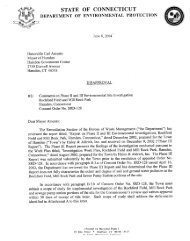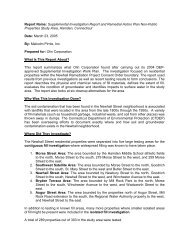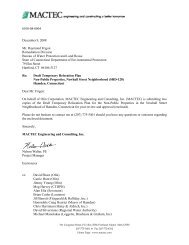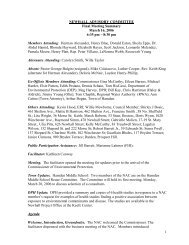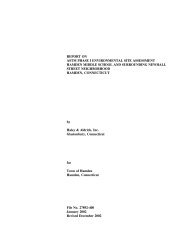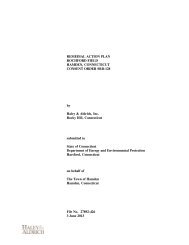Main Report - Newhall Remediation Project
Main Report - Newhall Remediation Project
Main Report - Newhall Remediation Project
- No tags were found...
Create successful ePaper yourself
Turn your PDF publications into a flip-book with our unique Google optimized e-Paper software.
Public Health Implications of Lead in Surface SoilSubstantial amounts of environmental sampling have occurred in the <strong>Newhall</strong> Streetneighborhood over the past 3 years. Surface soil samples collected from neighborhood yards(Table 3) indicate that lead was frequently found above its comparison value of 400 mg/kg. Leadis the contaminant found at the highest concentration in surface soil, relative to its comparisonvalue. Lead was detected at one property at concentrations more than 100 times above itscomparison value. The maximum lead level found in surface soil in a residential yard is 43,900mg/kg. Lead was found at levels above 400 mg/kg in approximately 50% of samples.Adults and children in the <strong>Newhall</strong> Street neighborhood could come into direct contact withcontaminated surface soil while working or playing in their yards. Exposure could occur throughdirect skin contact (dermal), eating soil particles adhered to fingers or food items (ingestion) orbreathing soil particles in the air (inhalation). Children have a greater potential for exposure tosoil than do adults. Children have more opportunities for contact with soil because they play onthe ground and in bare soil. Children also have greater hand-mouth activity, which leads to moresoil ingestion than is common for adults. In addition, children have a greater sensitivity than doadults to the harmful health effects from lead exposure.The high levels of lead found in the <strong>Newhall</strong> Street neighborhood were present in surface soilswhere children currently reside or resided in the past. As discussed previously, lead in soil can bean important route of exposure to lead.ATSDR has developed a screening procedure for evaluating exposures to lead (ATSDR 1999).ATSDR’s screening procedure uses a blood lead slope factor, which predicts the increase inblood lead per unit lead concentration in soil. The slope factor assumes continuous exposure. Thescreening procedure involves multiplying the lead level in soil by the percentage of outside timea person spends in their yard. This is then multiplied by the blood lead-to-soil lead slope factor.CT DPH used a blood lead slope factor for U.S. children of 0.0068, which is derived from astudy of U.S. children from 1–18 years of age (Angle et al. 1984). For adults, CT DPH used aslope factor of 0.001, which is based results from a study of U.S. males aged 18–65 years (Stern1996). For the percentage of outside time spent in the yard, CT DPH made two alternativeassumptions, shown in Table 4.The relationship between soil lead and blood lead depends on many factors, including thebioavailability 6 of lead in the soil, the chemical form of lead, the age of the exposed person, andthe person’s work or play habits. Using the ATSDR screening procedure, CT DPH estimated theincremental blood lead level for children and adults working and playing in soil in the yard withthe highest average lead level (calculated to be 11,800 mg/kg). Lead levels were not averagedacross multiple yards because exposure occurs mostly in one’s own yard rather than in otheryards in the neighborhood. The average lead concentration (11,800 mg/kg) was conservativelyestimated as the 95% upper confidence limit (UCL) of the mean, using EPA’s Pro UCL program(EPA 2001a). The results of the blood lead estimates are presented in Table 4.6 Bioavailability refers to the degree to which lead is available to the body. Bioavailability is influenced by howeasily the lead is absorbed from the soil into the body.17



